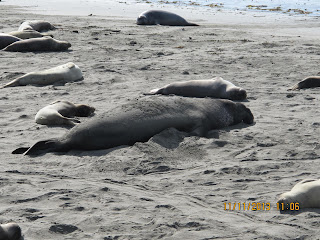Sleep apnea as a water and energy saving strategy for elephant seal."
She pointed out that elephant seals, because they have no access to fresh water, have a lot of adaptations in common with desert animals. They live as though they are in a desert. They are at risk of
dehydration. They have developed many strategies that desert animals have developed
to reduce water loss.
Elephant seals are different from most other mammals. No other mammal
fasts while lactating, or can lose so much body weight without serious
problems. Males stay on land for 100 days and lose 7 kg a day during the
breeding season. The top ranked male may lose about 41 percent of body weight.
Lower ranked males lose around 34 percent. Females fast for 30 days while
lactating. These are desert mammal adaptations. They have efficient kidneys and
elaborate nasal turbinates to recapture moisture.
Under water, they hold their breath to be able to catch
prey. On land, it helps them save water and energy. They are not the only seals
that hold their breath, but they hold their breath the longest. Other seals
include Weddel, harbor, gray and Hawaiian monk seals.
“They are so different from other animals that we called
them Martians in the lab,” she said.
On land, the seals breath in, breathe out, then breathe out
a little more, just as they do when they dive.
During lactation, it’s advantageous to produce less water
for milk to conserve energy. At the beginning of lactation, milk is 75 percent
water and 15 percent fat. By day 21, those percentages are reversed: 35 percent
water and 55 percent fat.
Weaned pups fast for 70 days.
Seals produce little urine or fecal material while fasting. The
urine they do produce is concentrated. The main route of water loss is through
respiration.
In the nasal turbinates, the branching structures visible inside the skull above, there is a counter-current heat
exchange, in which the breath is warmed on entering the body, so it takes up
more moisture, and cooled as it is exhaled, so that the moisture can be
recaptured. The turbinates provide increased surface area for moisture-exchange
membranes: 3140 cm2, over 3 square meters. 92 percent of respiratory water is
recovered. That compares to 24 percent in sheep, a comparable land mammal.
 Weaners develop longer apnea periods as they age. Those 60
days and older develop their apnea during the post-weaning fast.
Weaners develop longer apnea periods as they age. Those 60
days and older develop their apnea during the post-weaning fast.
Fewer breaths = less water loss. Each breath exhales 50 mg of H2O.
She monitored their heart rate and breathing rate during
apnea. Normal heart rate is 90 per minute while breathing, 40 per minute during
apnea.
The weaners she followed spent the night in the water.
During the fall haul-out, the young of the year spent more
time on the beach, four of her group never entering the water at all. They breathed
less. By 95 days old, weaners breathed 50 percent less than at 60 days. Young of
the year during their haul-out breathed 76 percent less.
They burn fat to create water. By conserving water, they are
able to retain fat reserves.
.JPG)









